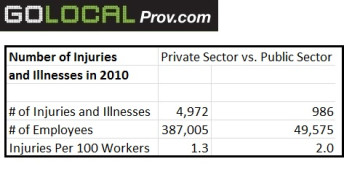INVESTIGATION: Government Worker Injuries Skyrocket
Thursday, December 08, 2011
Local and state government workers in Rhode Island claim injuries and illnesses at a far higher rate than their counterparts in the private sector, according to new data obtained by GoLocalProv.
In 2010, there were nearly two reports of injuries or illnesses for every 100 workers in local or state government, according to data provided by the Rhode Island Department of Labor and Training. At the same time, there were 1.3 injuries or illnesses for every one hundred private sector workers that resulted in three or more days missed from work.
GET THE LATEST BREAKING NEWS HERE -- SIGN UP FOR GOLOCAL FREE DAILY EBLASTAnd, injuries and illnesses among government workers are growing. From 2004 to 2009, the rate of injuries nearly doubled, from 1.1 to 2.0 for every hundred workers. The rate increased for government even while the number of government employees decreased, from a total of about 54,000 in 2004 to about 50,000 in 2009. Meanwhile, just about other industry in the private sector—including manufacturing and construction—saw decreases in injury rates that paralleled declines in the number of employees. (See below charts.)
The disparity between public and private sector workers mirrors national trends, according to Steve Malanga, a scholar at the Manhattan Institute, a public policy research institute in New York City.
‘Perverse incentives’ to claim more injuries?
Explanations as to why people who work in government jobs appear to have more injuries and illnesses varied widely among experts.
Malanga said some states have generous disability systems that create “perverse incentives” for workers to take more sick days off. He said the Rhode Island data is a possible indication that there are more incentives to miss time in government employment than private employment.
A spokeswoman for the Ocean State Tea Party in Action agreed. “Active and retiree employees’ disability claims, many of which are questionable at the least and egregious at worst, beg for an analysis of a causal relationship that may exist between compensation and benefits with many of these claims,” said spokeswoman Lisa Blais. “Policies and practices must be reformed to avoid providing for incentives to claim injury in cases that are clearly not traumatic, life-altering injuries.”
As long as there are incentives in place for government employees to take time off, she said costs for workers compensation and other benefits will skyrocket.
Mike Stenhouse, the CEO for the Rhode Island Freedom and Prosperity Center, blamed the difference in workplace cultures between the public and private sector. “I would expect that this difference would appear in these different cultures,” Stenhouse said. “The normal free market and competitive forces that would drive a person to work harder and achieve and receive rewards are not as prevalent in the public sector-entitlement culture.”
The claim that government workers have more of an incentive to claim injuries is “absolutely nonsense,” said Philip Keefe, president of the Service Employees International Union Local 580. “When I hear people say state employees abuse sick time, that is just not factual,” he said.
Blais said that local and state authorities in Rhode Island may not have been as aggressive in monitoring workers compensation claims as they should be. “The Ocean State Tea Party in Action questions the rigor of risk management at the state and local levels. Managing workers’ comp claims goes way beyond processing paperwork and forgetting about those claims,” Blais said.
She pointed to Providence, which recently began reviewing workers comp claims and as a result “claimed untapped cost-avoidance and savings” that had been missed because of past failures to actively manager work-related injury claims, according to Blais.
On a statewide level, she said the issue has implications for pension reform. Although the General Assembly just passed landmark pensions reform, two of the “biggest cost drivers of the problem” have yet to be addressed: disability pensions, specifically, and retiree health care.
Public safety: more injuries?
Union president Keefe said that there might be a higher injury rate among government workers because of police officers and firefighters. “The private sector does not generally deal with public safety and the public sector does,” Keefe said. “When you introduce folks into that situation there’s a much higher likelihood that they will be injured on the job.”
But Malanga found that even in comparable jobs the injury rate is still far higher, based on national data. For example, construction workers employed by cities or towns claim injuries at a rate of 9.5 for every 100 workers. Private construction workers, on the other hand, have four injuries for every one hundred workers. Likewise, public school teachers have 4.9 injuries compared to 2.2 for every 100 teachers in the private sector.
Keefe, however, said other public employees are subject to dangerous working environments as well. One is the Department of Children, Youth and Families, where Keefe is a supervisor and where 75 of the members of Local 580 work as investigators and an additional couple hundred members are social workers.
Investigators and social workers are more often than not called upon to intervene in unsafe home environments, Keefe said. “We are very often told by police departments, ‘What are you doing here? We don’t even go into these neighborhoods without backup.’ And we’re sending social workers and investigators … by themselves,” Keefe said.
“If you’re talking about public safety individuals, why isn’t my group included in that?” he added.
He also noted that public sector employees often are expected to continue working during emergencies, like a blizzard or a hurricane. “In the middle of a hurricane most private employers tell their people to stay home. We’re told just the opposite: ‘Get into work,’” Keefe said.
That holds true not only for snowplow drivers and police officers, but also for many workers at DCYF, where reports of child abuse and neglect normally require a response within eight hours, regardless of the time of day or weather conditions. And, in emergencies, DCYF investigators have to leave the building within ten minutes, Keefe said.
Yet another possible reason for the disparity in injury rates: Keefe said public workers might feel more comfortable reporting an injury or an illness than a private sector worker. “If you’re a private employee and you are non-union that’s an easy excuse to be fired,” Keefe said. “If you’re in a union you have a much stronger legal protection because we have contracts in place.”
If you valued this article, please LIKE GoLocalProv.com on Facebook by clicking HERE.







